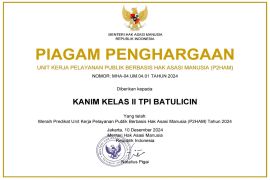Jakarta (ANTARA) - The number of fake banknotes circulating in public fell in 2020 compared to the previous year, driven by an increase in digital transactions and the COVID-19 pandemic, a Bank Indonesia (BI) official has said.
“Compared to 2019, fake banknotes found throughout 2020 fell, with their ratio (reaching) five bills out of one million bills. Meanwhile, throughout 2019 compared to the previous year, the average ratio was found to be nine bills out of one million bills of circulated Indonesian rupiahs,” BI’s money management executive director, Marlison Hakim, disclosed during a press conference here on Wednesday.
On account of rising digital transactions, throughout the first quarter of 2021, the fake banknote ratio was found to be very low — two bills out of one million circulated bills, he said.
“So, it (the fall in circulation of fake currency) occurred during the COVID-19 pandemic, also due to increasing digitalization. It strongly led to the fall of fake banknotes found in public,” Hakim noted.
The central bank has carried out preventive activities as part of efforts to anticipate any rise in fake banknote circulation during Eid Al-Fitr 2021, he said. BI continues to improve the quality of components and elements of rupiah’s security, he informed.
Related news: Ramadhan: BI raises alert on fake currency, prescribes e-transactions
The most important preventive measure is educating people by asking them to take care of rupiah banknotes with “acts of love, pride, and understanding”, Hakim said.
“One of the love elements is how our people engage each other to recognize, take care, and keep (the rupiah). We ask people to recognize our rupiah with 3D: to be seen, to be touched, and to be looked up,” he explained.
The act of love for the rupiah is a manifestation of the public’s capability in understanding the rupiah as an official means of payment, the RI’s sovereignty symbol, and people’s unifying tool, he said.
The act of understanding the rupiah is a manifestation of the public’s capability in understanding the rupiah’s role in money circulation, economic stability, and its function as value saver, he added.
The act of pride involves people understanding the rupiah’s function in payment transactions, spending the rupiah, and optimizing the rupiah’s value, he continued.
BI has projected that digital banking transactions will reach Rp32,206 trillion by 2021, or higher than digital transactions of Rp27,036 trillion recorded in 2020.
Furthermore, the central bank has reported that the digital ecosystem, through e-commerce platforms, is fast gaining traction among the public. In February this year, e-commerce transactions touched Rp27.2 trillion, reflecting an increase of 45.28 percent year on year. In terms of volume, transactions surged 107.1 percent (year on year) to reach 174.6 million.
Related news: Police detain woman over alleged circulation of fake banknotes










